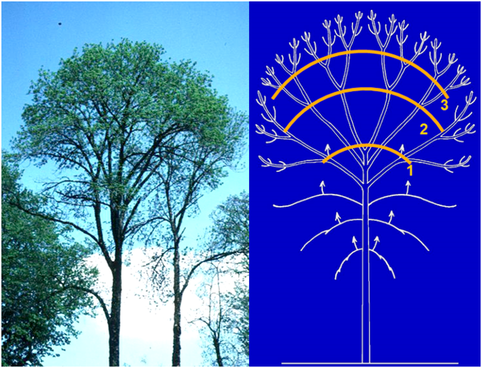Preliminary Course
Botany. Architectural Analysis
Architectural Unit
Sequence of development
From germination to death, the development of a plant is like the expression of precise and ordered sequences of morphogenetic events.
The architectural sequence of development of the species summarizes the main morphological stages of differentiation of plant ontogeny.
Those stages usually follow this path
-
- The young tree expresses its architectural unit
- The adult tree duplicates (reiterates) it at the top of the main stem. This process of reiteration is sequential and gives rise to a more complex crown
- The mature tree has a crown made up of a succession of reiterated complexes
- The senescent tree shows a fragmented crown with dead main branches and delayed reiteration processes
The following example illustrates several main morphological stages.

Architectural sequence of development in Fraxinus excelsior: Drawings of some key morphological stages (Drawings D. Barthélémy, CIRAD)
Top Left: The young plant (a, b, c, d, e); from the seedling to the first growth units. Scale: 10 cm.
From the young plant to the mature tree with its reiterations (f,g,h). Scale: 2 m.
Arrows in (h) show delayed reiteration complexes.
The following example shows a classical sequence of development, including automatic reiteration apparition.

Diagrammatic representation of the architectural sequence of development in Fraxinus excelsior (to compare with the drawing above)
(from Barthélémy et al.,2007); highest category axes are not represented.
The young plant expresses step by step (A and B) its architectural unit (in B)
The plant duplicates the architectural unit automatically during the following stages of development (C and D)
The mature plant builds a complex crown made of a succession of reiterated complexes (D).
At later stages, delayed new reiterated complexes appear (arrows in D).

Succession of reiterated complexes in Fraxinus excelsior (Photo and drawing courtesy D. Barthélémy, CIRAD)
Left: a crown view.
Right: delayed reiterated complexes (arrows) appear in successive waves, gradually colonizing the crown.
Bibliography
Barthélémy, D., Caraglio, Y. 2007. Plant Architecture: A Dynamic, Multilevel and Comprehensive Approach to Plant Form, Structure and Ontogeny. Annals of Botany, 99 (3) : pp. 375-407 19 (access to paper and pdf)
Nicolini, E., Chanson, B., Bonne, F. 2001. Stem growth and epicormic branch formation in understorey beech trees (Fagus sylvatica L.). Annals of Botany, 87 (6) : pp. 737-750 (access to paper and pdf)
Definition
Architectural Unit
Botany. The architectural Unit of a given plant species is the specific expression of its architectural model. The architectural Unit of a plant can be seen as a hierarchical branched system in which the axes can be grouped into categories according to their morphological, anatomical or functional distinctive features (Barthélémy et Caraglio, 2007).See also: Architectural Model.
